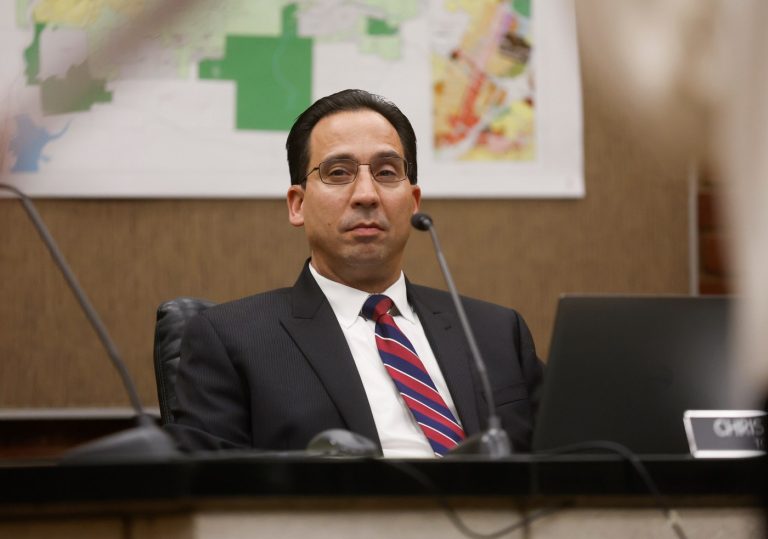SCOTTSDALE — Big 12 commissioner Brett Yormark “certainly wasn’t happy” with the College Football Playoff’s revenue distribution plan starting in 2026 — a plan that leaves his conference and the ACC at a significant disadvantage to the SEC and Big Ten — but wasn’t in position to complain.
His competitive streak, honed over the decades, wouldn’t allow it.
“I’m a believer that if you create value, you need to be rewarded — that’s just how I look at life,” Yormark said Wednesday following the Big 12’s spring meetings at a Scottsdale resort.
Yormark addressed a series of issues at the forefront of college athletics during two public sessions: The first with a small group of reporters; the second as a panelist on college football during an event at the annual Fiesta Summit.
On CFP revenue
The conferences agreed earlier this spring to a revenue-sharing plan for the next contract cycle with ESPN, which begins in 2026.
It allocates about 60 percent of the reported $1.3 billion in annual revenue to Big Ten and SEC, with the ACC and Big 12 accounting for approximately 30 percent. The breakdown was based, in part, on CFP participation over the past decade.
Teams in the new Big 12 have accounted for just two of the 40 semifinal berths, with Cincinnati and TCU earning bids. The SEC and Big Ten combined for 29 spots.
“When you look at the first 10 years of the CFP,” Yormark said, “we didn’t perform probably as well as we would have liked. That’s OK. History might not repeat itself.”
The CFP “opener”
The Big 12 and ACC had little leverage with the Big Ten and SEC, which feature most of the biggest brands in the sport. But during the negotiations, Yormark pushed for what’s called a “look-in” (or “opener”) in the contract midway through the six-year term.
It gives the commissioners a chance to reconfigure the economic piece if participation trends shift from the benchmarks used to create the initial distribution plan.
“Having that look-in made sense for a lot of different reasons,” Yormark said.
“I certainly wasn’t happy with the distribution … And I don’t think our (athletic directors) or our coaches are either, but we’re going to continue to invest for the right reasons.
“We’re going to continue to build football. It’s at the core of what we do, and I’m excited about the future.”
On CFP expansion
While the revenue model for the next edition of the CFP was established earlier this spring, many specifics are unresolved, including the number of teams.
The event is expanding to 12 teams for the 2024-25 seasons. But starting in the fall of 2026, it could grow to 14.
“If we end up going to 14 and we can further enhance the championship experience for more teams and more student-athletes, that’s great,” Yormark said.
“More is good, but the proof is in the details, and I’m excited to see how this year plays out at 12.”
On college football separating
Many in college sports believe football should be declared a separate entity from all other NCAA sports, including basketball.
A group of sports executives even pitched the “super league” concept to conferences in recent months.
“I think that’s noise,” Yormark said. “I don’t see that happening for the foreseeable future.”
Related Articles
2025 NFL Draft: Our projections for the top West Coast prospects
NFL Draft winners and losers: Pac-12 shines before extinction while new versions of SEC, Big Ten dominate
Mailbag: Lincoln Riley, Bobby Hurley on hot seats at Pac-12 schools
Pac-12 recruiting: ASU’s wild week, UCLA keeps Toia and Deion’s latest
NFL Draft winners and losers from the first round: Pac-12 stands tall while SEC leads the way
On NCAA Tournament expansion
SEC commissioner Greg Sankey has been perhaps the greatest proponent of exploring an expansion of March Madness, which has featured 64 or 68 teams since 1985. The expanded field size often cited is 78 teams.
The Big 12 is one of the top basketball conferences in the country and will get bigger and stronger next season with the addition of Arizona, ASU, Utah and Colorado.
Yormark said the coaches are in favor of expansion “in theory.”
“But what does that number look like?,” he added. “The devil is in the details.”
Critics of expansion worry that the power conferences will gobble all the newly-created spots and marginalize the mid-majors and smaller schools that give the tournament its captivating chaos and upsets.
“You don’t want to mess with something that’s great,” Yormark said, “but if there are chances and opportunities to modify a little bit, to maybe provide more access, to amplify the experience, to look at it slightly differently, we owe it to ourselves to do that.”
“I’m a firm believer that from time to time, you’ve got to put things through an audit.”
*** Send suggestions, comments and tips (confidentiality guaranteed) to pac12hotline@bayareanewsgroup.com or call 408-920-5716
*** Follow me on Twitter/X: @WilnerHotline
*** Pac-12 Hotline is not endorsed or sponsored by the Pac-12 Conference, and the views expressed herein do not necessarily reflect the views of the Conference.












